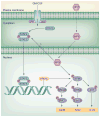Regulation of the life cycle of HPVs by differentiation and the DNA damage response
- PMID: 24266355
- PMCID: PMC3951404
- DOI: 10.2217/fmb.13.127
Regulation of the life cycle of HPVs by differentiation and the DNA damage response
Abstract
HPVs are the causative agents of cervical and other anogenital cancers. HPVs infect stratified epithelia and link their productive life cycles to cellular differentiation. Low levels of viral genomes are stably maintained in undifferentiated cells and productive replication or amplification is restricted to differentiated suprabasal cells. Amplification is dependent on the activation of the ATM DNA damage factors that are recruited to viral replication centers and inhibition of this pathway blocks productive replication. The STAT-5 protein appears to play a critical role in mediating activation of the ATM pathway in HPV-positive cells. While HPVs need to activate the DNA damage pathway for replication, cervical cancers contain many genomic alterations suggesting that this pathway is circumvented during progression to malignancy.
Figures



References
-
- Zur Hausen H. Papillomaviruses and cancer: from basic studies to clinical application. Nat Rev Cancer. 2002;2(5):342–350. - PubMed
-
- Markowitz LE, Dunne EF, Saraiya M, Lawson HW, Chesson H, Unger ER. Quadrivalent human papillomavirus vaccine: recommendations of the Advisory Committee on Immunization Practices (ACIP) MMWR Recomm Rep. 2007;56(RR-2):1–24. - PubMed
-
- Moody CA, Laimins LA. Human papillomavirus oncoproteins: pathways to transformation. Nat Rev Cancer. 2010;10(8):550–560. Describes the critical role of the ATM DNA damage pathway in HPV genome amplification. - PubMed
-
- Harper DM, Franco EL, Wheeler CM, et al. Sustained efficacy up to 4.5 years of a bivalent L1 virus-like particle vaccine against human papillomavirus types 16 and 18: follow-up from a randomised control trial. Lancet. 2006;367(9518):1247–1255. - PubMed
-
- Wheeler CM, Castellsague X, Garland SM, et al. Cross-protective efficacy of HPV-16/18 AS04-adjuvanted vaccine against cervical infection and precancer caused by non-vaccine oncogenic HPV types: 4-year end-of-study analysis of the randomised, double-blind PATRICIA trial. Lancet Oncol. 2012;13(1):100–110. - PubMed
Publication types
MeSH terms
Grants and funding
LinkOut - more resources
Full Text Sources
Other Literature Sources
Medical
Research Materials
Miscellaneous
